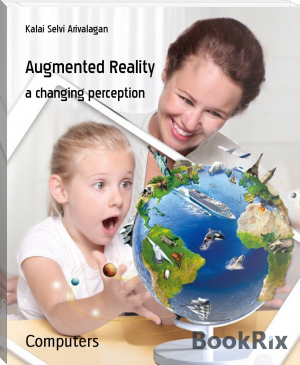Augmented Reality - Kalai Selvi Arivalagan (free ebook reader for iphone .txt) 📗

- Author: Kalai Selvi Arivalagan
Book online «Augmented Reality - Kalai Selvi Arivalagan (free ebook reader for iphone .txt) 📗». Author Kalai Selvi Arivalagan
Augmented Reality – a Changing Perception
Augmented reality technology shows us the real-world environment with added layers of digitally conceived information. Education, hospitality, manufacturing, and automotive sectors are trending industries where augmented reality has brought tremendous changes at all levels. It is not an exaggeration that augmented reality has brought a change in the perception of reality with the help of technology.
How Augmented Reality works
Augmented reality applications utilize data comprising animations, images, videos, and 3D models to display results in both synthetic and natural light. The results can be displayed on smart glasses and handheld devices.
Augmented reality applications superimpose digital information atop physical objects and surfaces and help users to get their much-needed information with ease. Being connected to cloud servers, augmented reality applications provide real-time updated imageries and scenes to users. If you want to run augmented reality applications only limited technology related resources are required. A dedicated hardware like Hololens, HTC Vive, or Oculus Rift is not required.
Simultaneous Location and Mapping, Depth Tracking, and Image Processing and Projection are the three significant technologies that empower Augmented Reality apps to put on top digital images atop physical surfaces.
SLAM (Simultaneous Location and Mapping)
With the help of sensors in an accelerometer or a gyroscope, SLAM maps an object or an entire space. Once mapping is completed, SLAM runs an AR image simulation that projects the image on a screen or a physical space in the appropriate dimension.
Depth tracking
Depth tracking measures the distance between the camera sensor and the object. It determines the dimension and the size of the actual environment where the virtual object is projected. Depth tracking focuses on the object and ignores the background to process the image for AR simulation.
Know Your Augmented Reality Types
Marker-based AR
In this type, the image recognition requires a camera and a printed QR code to scan the object. QR Code is only one option. Marker can be anything an image which the app is trained on. Marker can be another object as well. For example, in Ford AR, the car is used as a marker to project the digital content. The AR device calculates the orientation and the position of the marker to target the content. A marker initiates digital content for the users to view.
Markerless AR
In the absence of marker, the digital content can be augmented using surface detection. This includes vertical surface detection and horizontal surface detection. The type of surface detection to be used depends on the object to be augmented.
For example if you are augmenting a car, it should be placed on a horizontal surface. If you are augmenting a clock, the same has to be placed on a vertical surface. The method of surface detection to be used will be programmed at the time of development. So the user will not be able to place a content meant for vertical surface on horizontal surface and vice versa.
The position-based or location-based augmented reality utilizes a compass, a GPS, an accelerometer, or a gyroscope to generate data based on the location of the user. With the available data, it produces directions, maps, or information on any nearby business for navigation support, business ads pop-ups, and events.
Role of Augmented Reality in Automotive
The future of automobile industry belongs to self-driving cars and transportation vehicles. Manufacturing of cars involve precise assembling of hundreds of components in a sequence. AR makes assembly work easy by projecting instructions on data glasses or displays. Technical aspects of vehicles can be presented in a more compelling format than printed brochures or catalogs.
Product Development
Augmented reality has made it easier to create new models. New models or variants need not made manually. AR applications have made it possible to display different models with different colours and shapes. In an automobile engineering unit, technicians can integrate varied engine variants into a chassis. It helps to decide if a yet-to-be designed engine will fit into the engine compartment of an existing vehicle.
Augmented reality plays an important role in the designing phase of a vehicle. It enables the technicians to check and modify parts in the early stage of production and saves unnecessary cost and time before the launch. The augmented reality apps enable the production team to view how the car will be on the road.
Quality Improvement
With its ability to display tutorials, workflows, and production procedures in multimedia that suits the context, AR helps employees to get trained fast and also efficiently. Tracking deviations in production processes help technicians to detect errors and get them rectified quickly and easily.
Easier Maintenance
Augmented reality helps technicians to identify parts to be replaced by displaying them on the screen. Even the defective parts in the vehicle can be marked in a specific colour. It also helps mechanics to do a thorough job by following the instructions displayed on the screen for easy reference. With 3D visualisation, AR enables mechanics to explore different specification of the car with ease.
Augmented reality provides technical assistance to technicians to service vehicles perfectly with ease. With the growing complexity in the functioning of vehicles, service professionals must be updated with the latest information. AR helps them with step by step instructions on how to assemble parts, which tools need to be used, know the right configuration and perform specific tasks without any errors. The display shows the labeled parts and guides them with instructions on how to fix them and complete the work without much difficulty.
Augmented reality has brought several advantages to the automotive sector by helping drivers to drive with ease on any kind of terrain, by helping students to learn driving easily from their instructors, and has promoted an increased level of awareness on safety also.
Sales Process (Pre sales, Sales and After Sales)
AR apps during pre sales
Augmented reality application helps auto OEMs to promote sales of vehicles even before initiation of actual sales process. Instead of developing an app for their product, vehicle manufacturers can now integrate AR feature in their website. AR application enables customers to have a contactless experience and choose their own choice of colors, accessories, and specialized features for their vehicles. From wherever they are prospective customers can visit the manufacturer’s website or download the app for mesmerizing 3D exploring experience to choose their vehicle.
Augmented reality application during sales
With its portable nature, augmented reality application helps automobile dealers to reach more customers and take customer satisfaction levels to a new height. Within the available showroom space, AR apps help dealers to showcase all models with its variants along with their preferred colors and accessories to their customers. The sales person can also showcase vehicles in a realistic manner at the customer’s location.
Augmented reality application during post sales
With its digital manuals, augmented reality applications guide customers to know about their vehicles in detail. The digital manuals help prospective customers to learn simple procedures such as changing coolant or checking oil levels on their own. Integration of AR application on smart glasses helps service technicians to do a thorough job for immediate help can be availed through video guides, live support from senior technicians and job card details.
Ultimately, time has come for different brands to recognise the tremendous scope of augmented reality in operations that promoted pre-sales, post-sale support and point-of-sale operations. With the help of the smartphone, augmented reality offer enhanced technical and sales support with its content and interaction abilities. For example, Hyundai come out with an augmented reality based digital manual that can help drivers to troubleshoot issues without visiting a facility. AR user guide helps the drivers to check oil levels, replacing air filters and filling up windshield fluid on their own. AR-based user manual features a Virtual Technician that provides instructions or procedures to install electronic devices or to operate appliances.
ImprintPublication Date: 07-06-2020
All Rights Reserved
Dedication:
Augmented Reality - a wonder to unfold





Comments (0)